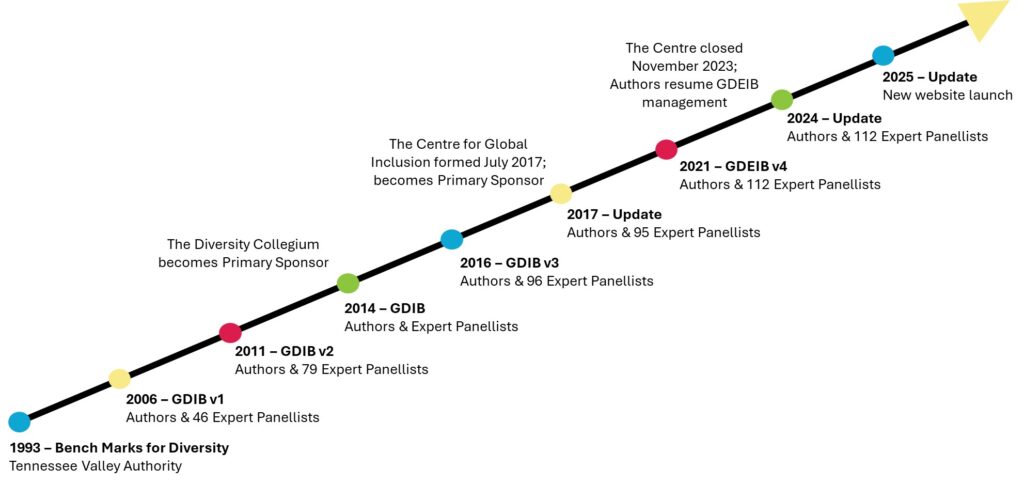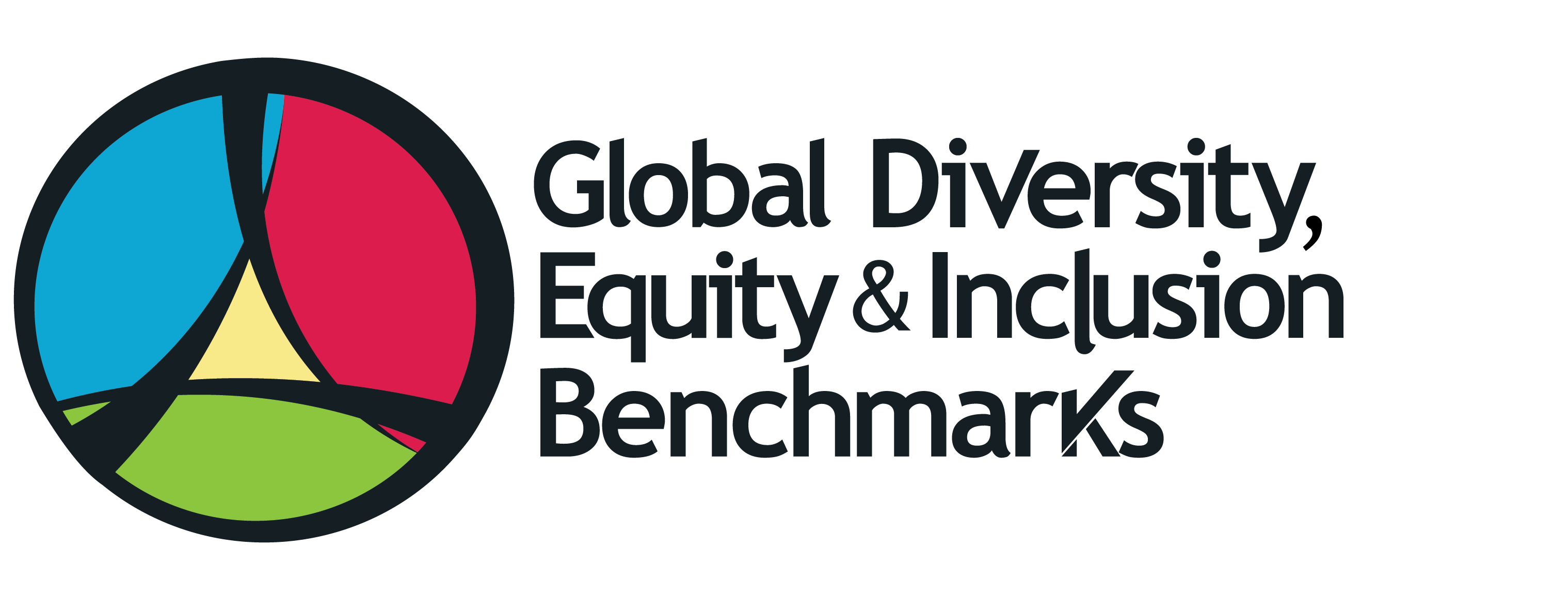The GDEIB Model

The equilateral triangle symbolizes equality and solidarity or strength. The Foundation categories form the base of the triangle. The Bridging categories are displayed as a circle in the centre connecting the Foundation, Internal, and External categories.
The lines separating the four groups are differently sized dashes symbolizing permeability and interconnectivity reflecting the systemic nature of DEI.
For each category, the benchmarks are divided into five levels that indicate progress toward the best practices in that category.
LEVEL 5: BEST PRACTICE
Demonstrating current global best practices in DEI; exemplary.
LEVEL 4: PROGRESSIVE
Implementing DEI systemically and showing improved results and outcomes beyond what is required or expected.
LEVEL 3: PROACTIVE
A clear awareness of the value of DEI; starting to implement DEI systemically. This is what is required and expected of all organizations.
LEVEL 2: REACTIVE
A compliance-only mindset; actions are taken primarily to comply with relevant laws and social pressures. Doing the bare minimum.
LEVEL 1: INACTIVE
No DEI work has begun; diversity, equity, and inclusion are not part of organizational goals.
Historic background of the GDEIB

The need to create benchmarks grew out of an ongoing discussion Julie O’Mara and Alan Richter were having with each other and with other practitioners. They were bemoaning the fact that in the 1990s so many D&I practitioners considered activities such as having ethnic food in the cafeteria, placing pictures of minorities and international places in the organization lobby, offering cultural fairs, and creating some employee groups; the extent of their diversity program. Julie and Alan began creating the GDIB (Global Diversity & Inclusion Benchmarks) to help organizations make systemic interventions needed to produce effective DEI results.
The origin of the GDIB began with the Bench Marks for Diversity, published in 1993 by the Tennessee Valley Authority (TVA), a government organization in the United States. The original researchers were Kate Atchley, JoAnne Howell, Gerald Landon, Vergil Metts, and Hector Qirko. Because Bench Marks for Diversity was developed with federal U.S. funds, it was not copyrighted.
That original document was substantially reconfigured, revised, and made to reflect a global perspective. The first GDIB was published in 2006 by the GDIB authors at the time, Julie O’Mara and Alan Richter, PhD. It was sent to 47 Expert Panellists asking for comments and suggestions. Those were compiled by the authors and then sent for review by the Expert Panellists. The authors finalized the work, making judgments on what to accept and what not to accept.
For the 2011 edition, the Expert Panellist group was expanded to 80, with some original members leaving and new ones joining. The process was similar to the 2006 process. With this edition we added the model.
In 2013, The Diversity Collegium, a think tank of practitioners, scholars, and thought leaders became the primary sponsor and home of the GDIB. We created a 2014 edition to include the sponsorship and improved the look and feel of the 2011 GDIB as well as improvements to the introductory material. No substantial changes that required research by the Expert Panellists were made.
For the 2016 Tenth Anniversary Edition the number of Expert Panellists grew to 95, including many who worked on the earlier editions. In addition to updating the benchmarks themselves to reflect current practices, we changed the conceptual frameworks to approaches for D&I to reflect the way D&I work was practiced added a new category on Connecting D&I and Sustainability, added a description of the Ultimate Goals of D&I, added an explanation of practicing D&I work as a systems approach, and revised the model.
In 2017, we formed The Centre for Global Inclusion and created a new edition of the GDIB with minor updates.
The 2021 edition is the first one to adopt the new name—GDEIB (Global Diversity, Equity & Inclusion Benchmarks). This edition is a major revision with numerous improvements. We added a third author, Nene Molefi, who had been an Expert Panellist, and enlarged the global panel of experts (EPs) to 112.
We included input from a DEI Futures Project in 2018 which included a 2.5-day conference attended by 85 people from around the world. We also incorporated feedback from our users, including conducing a user group survey.
There were three rounds of feedback from our Expert Panellists, including small group work that focused on specific dimensions, categories or issues. These small groups of Expert Panellists were asked to delve deeply into pressing issues to be sure that the 2021 edition was relevant to the changes—some said disruption—that has been a factor over the last several years. These were the small groups:
- Sustainability
- New Normal / Pandemic
- Technology of the Future / Artificial Intelligence / Robotics
- Ability / Disabilities
- Ensuring Global Inclusion in All Aspects
- Gender, Sex, Gender Identity, Transgender / Pronouns / LGBTQ+
- Race, Racial Identity, Terminology & Related Complexities
- Religion
- Incorporating Equity and Renaming the GDEIB
- Generational Differences
- Socio-Economic Class
- The Different Approaches to DEI
- Improve the Benchmarks that are Internally Focused
- Refresh Supplier Diversity
In March 2024, this current edition was produced primarily because The Centre for Global Inclusion closed in November 2023 and we established a new website at www.GlobalDEIBenchmarks.org. We also found some typos and changed a few other items. The research was conducted in 2021 and has not been changed in this edition.
